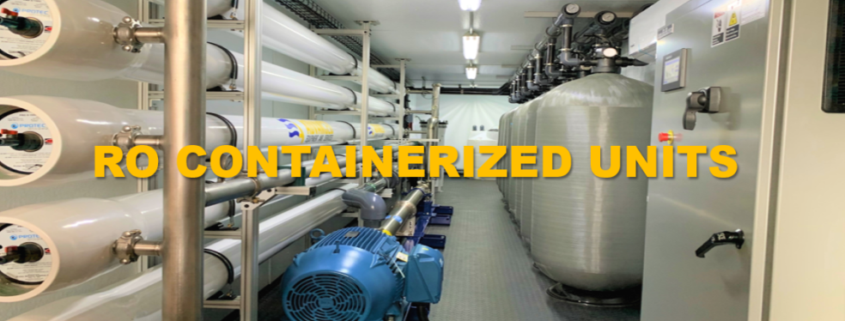Containerized Reverse Osmosis (RO) Systems for Efficient Water Treatment
Portable, efficient containerized Reverse Osmosis (RO) systems treat water in industrial, municipal, and rural situations. Containerized pre-assembled systems are easy to move, deploy, and install.
What Are Containerized ROs?
A shipping container-based reverse osmosis system treats water. These systems work like permanent RO systems but are mobile, easy to set up, and compact. Containerized RO systems can treat seawater and brackish water for potable and industrial usage.
Key Benefits of Containerized RO Systems
1. Easy and Fast Deployment
Containerized reverse osmosis systems arrive on-site pre-assembled and ready for installation, reducing setup time to less than a day. Simply connect the system, and it’s ready to function.
2. Mobility and Flexibility
The containerized design allows for easy transport and quick relocation, making these systems ideal for disaster relief, temporary water treatment, and projects requiring portable solutions.
3. Cost-Effective and Time-Saving
These pre-assembled systems reduce labor costs and commissioning time compared to traditional water treatment installations. They also require minimal on-site construction.
4. Space-Saving Design
Containerized RO systems are compact and built to fit into shipping containers, making them ideal for locations with limited space. This design also provides protection for all system components, increasing service life.
5. Scalability and Customization
These systems can be specifically tailored to meet varying water treatment needs. They can also be easily scaled by adding more units, providing flexible solutions for growing demands.
How Containerized RO Systems Work
Reverse osmosis is a filtration process that removes dissolved salts, minerals, and other contaminants from raw water by forcing it through RO membranes. In containerized RO systems, this process is combined with pretreatment systems, chemical dosing, and high recovery rate technology to ensure optimal performance.
A typical containerized RO system includes:
Pre-treatment units: These remove suspended solids and prepare the water for filtration.
RO membranes: High-rejection membranes filter out chemical contaminants, bacteria, and other impurities.
Energy recovery systems: These minimize power consumption and increase efficiency.
Post-treatment: Final adjustments to feed water quality ensure water meets required standards.
CIP (Clean-in-place) flushing: Ensures the system operates at peak efficiency and prolongs membrane life.
Applications of Containerized RO Systems
1. Industrial Water Treatment
These systems treat large volumes of water to meet industrial standards for process water.
2. Desalination
Containerized RO systems are widely used in seawater desalination, converting seawater into potable water in remote coastal areas or for industries.
3. Municipal Water Treatment
Municipalities use containerized systems to improve water quality for residents, particularly in regions facing water scarcity or contamination issues.
4. Emergency and Disaster Relief
Their mobility makes these systems ideal for disaster relief, providing immediate access to clean water in emergency situations.
5. Agriculture
Containerized RO systems can treat water for irrigation, ensuring crops receive high-quality water that meets agricultural standards.
Maintenance Tips for Containerized RO Systems
Regular Filter Replacement
Replace pre-treatment filters and RO membranes regularly to maintain system efficiency.
Monitor Water Quality
Continuously monitor feed water quality to ensure the system is performing optimally and delivering clean, safe water.
Inspect Components
Check pumps, filters, and other system components regularly to ensure the system operates as expected.
CIP Flushing
Perform regular CIP flushing to remove any built-up particles that could reduce system performance.
Why Choose Containerized RO Systems?
1. Efficiency and High Recovery Rate
Containerized reverse osmosis systems are designed for high-efficiency water filtration, removing a wide range of contaminants and ensuring a high recovery rate of clean water.
2. Customization
These systems can be customized to meet specific needs, including brackish water, seawater desalination, and industrial water treatment.
3. Durability
Housed in durable shipping containers, these systems are built to withstand harsh environments and extend service life.
4. Remote Monitoring and Operation
Containerized systems offer remote monitoring capabilities, allowing operators to manage the system’s performance from anywhere.
5. Lightweight and Flexible
Their self-contained design makes them easy to install, move, and adjust to changing water treatment needs.
How Advanced Equipment and Services Help
We offer containerized reverse osmosis systems at Advanced Equipment and Services (Advancees.com). The solutions we offer are efficient, versatile, and reliable, adapted to each client’s demands.
We design desalination, industrial, and municipal water treatment containerized RO systems.
Our pre-assembled units reduce downtime by being ready for installation.
We offer scalable solutions to match your water treatment process’s rising needs.
We give experienced support and maintenance to keep the system running well for years.
Turnkey Solutions: Our turnkey solutions include all the components needed for seamless integration into your operation.
Select Advanced Equipment and Services for reliable, high-performance containerized reverse osmosis systems for water treatment. Find out how our unique solutions can help you meet your water quality goals by contacting us today!



